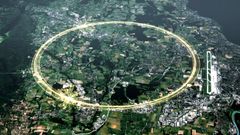Large Hadron Collider
 | |
The Large Hadron Collider (LHC) is the world's largest and most powerful particle collider and the largest machine in the world.[1] It was built by the European Organisation for Nuclear Research (CERN) between 1998 and 2008 in collaboration with over 10,000 scientists and hundreds of universities and laboratories, as well as more than 100 countries.[2] It lies in a tunnel 27 kilometres (17 mi) in circumference and as deep as 175 metres (574 ft) beneath the France–Switzerland border near Geneva.
First collisions were achieved in 2010 at an energy of 3.5 tera electronvolts (TeV) per beam, about four times the previous world record.[3][4] After upgrades it reached 6.5 TeV per beam (13 TeV total collision energy, the present world record).[5][6][7] At the end of 2018, it entered a two-year shutdown period for further upgrades.
The collider has four crossing points, around which are positioned seven detectors, each designed for certain kinds of research. The LHC primarily collides proton beams, but it can also use beams of heavy ions: Lead–lead collisions and proton-lead collisions are typically done for one month per year. The aim of the LHC's detectors is to allow physicists to test the predictions of different theories of particle physics, including measuring the properties of the Higgs boson[8] and searching for the large family of new particles predicted by supersymmetric theories,[9] as well as other unsolved questions of physics.
References
- ↑ "The Large Hadron Collider"
- ↑ "Large Hadron Collider: Thirteen ways to change the world"
- ↑ "CERN LHC sees high-energy success"
- ↑ "LHC to run at 4 TeV per beam in 2012"
- ↑ "Proton beams are back in the LHC"
- ↑ "Large Hadron Collider turns on 'data tap'"
- ↑ "LHC smashes energy record with test collisions"
- ↑ "Missing Higgs"
- ↑ "Towards a superforce"
Wikipedia is not affiliated with Wikispooks. Original page source here